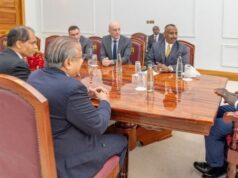
February 16-28, 2019
Kissing the shores of the Indian Ocean, Mombasa Port is the life line for the landlocked countries like Uganda, Rwanda, Burundi and D R Congo. In December 2018, a leaked report revealed that the Port was used as collateral for the $3.2 billion loan from China to build the rail link connecting Mombasa and Nairobi. Kenya faces the risk of loosing the port if it defaults on the loan contracted. There are allegations that more assets are mortgaged, though there is no way to discern the veracity of these allegations.
Kenya is only an archetypal case. China’s state sponsored lending to Africa has grown ten-fold in the last five years; lent mainly to fund the large infrastructure projects. The top debtors include Ethiopia($12.2 bn), Kenya( $7.5bn),Madagascar ($5bn) , Djibouti($ 4.5bn) and the list is expanding .In a recent development, South Africa’s Eskom Facility plant was granted a loan of R33.4 billion with a 5- year grace period, by the Chinese Exim Bank . The loan repayments will start in June 2019 for a 10 – year period and default in payment will end up China gaining absolute control of the plant.
Last year, China was accused of acquiring Zambia’s national electricity supplier (?) and rebuilding Mogadishu seaport in return for exclusive fishing rights along the Somali coast, though the allegations were refuted by the Chinese government. The opaque nature of the Chinese deals in Africa has kept the public in the dark about the consequences of the deals. Africa’s weak economic diplomacy and negotiating skills make it vulnerable to arm twisting to extract economic or political concessions. This is especially true in the cases of smaller countries with weak governments.
Africa should find solutions from within to combat this menace. Most of the countries do not have a well developed legal system or expertise to guard their interests in bilateral negotiations. The Central Banks, which should be the watch dog of the financial sector are in the process of evolution in most of the countries. Bi-lateral loans unlike the multinational arrangements from World Bank or IMF, do not insist on structural adjustments or prudential norms while lending. The loans from multilateral sources always come with conditions, which take into account repaying capacity, debt burden, reform process etc. Organizations like African Development Bank should be more proactive in this regard not only in extending legal support but also grooming legal and financial expertise within the continent to safeguard their commercial interests. Lest, the chances of debt trap would loom large.





